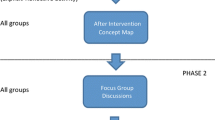Abstract
The purpose of this qualitative case study was to describe how the JASON project was implemented in a self-contained fourth grade classroom and to examine this project within the overall context of student--scientist partnership (SSP) models of science education reform. Additionally, this study examined and described any changes in student conceptions of the nature of science as a result of participating in JASON. The primary sources of data were verbatim transcripts derived from semistructured student and teacher interviews along with notes acquired through participant observation. Overall, results indicate that the project had a notable impact on short-term attainment of science content for participants, however little change was seen in their conceptions of the nature of science. Technology was underutilized across all areas of the program and there was essentially no communication between students and scientists. These findings are related to the instructional decisions of the classroom teacher which were directly influenced by the professional development workshop available for this program. Although this project has great promise to serve as an excellent model for bringing students and scientists together to facilitate an understanding of the nature of science, that potential was not realized.
Similar content being viewed by others
REFERENCES
Abd-El-Khalick, F., and Lederman, N. G. (2000). The influence of history of science courses on students' views of the nature of science. Journal of Research in Science Teaching 37: 1057–1095.
American Association for the Advancement of Science. (1989). Project 2061: Science for All Americans, Oxford Press, New York.
American Association for the Advancement of Science. (1993). Benchmarks for Science Literacy, Oxford Press, New York.
Barab, S. A., and Hay, K. E. (2001). Doing science at the elbow of experts: Issues related to the science apprenticeship camp. Journal of Research in Science Teaching 38: 70–102.
Bazler, J. A., Spokane, A. R., Ballard, R., and Fugate, M. S. (1993). The Jason Project and attitudes toward science as an enterprise and career. Journal of Career Development, 20: 101–112.
Bishop, B. A., and Anderson, C. W. (1990). Student conceptions of natural selection and its role in evolution. Journal of Research in Science Teaching, 27: 415–427.
Boujaoude, S. (1995). Demonstrating the nature of science: Three experiments that help students comprehend scientific principles. Science Teacher 62: 46–49.
Bruckerhoff, C. (1998). JASON IX: A Summative Evaluation. Report of The JASON Foundation.
Bybee, R. W., Powell, J. C., Ellis, J. D., Giese, J. R., Parisi, L., and Singleton, L. (1991). Integrating the history and nature of science and technology in science and social studies curriculum. Science Education 75: 143–155.
Cohen, K. C. (1997). Internet Links for Science Education: Student–Scientist Partnerships, Plenum Press, New York.
Evans, C. A., Abrams, E. D., Rock, B. N., and Spencer, S. L. (1999). Student/Scientist Partnerships: A Teacher's Guide to Evaluating the Critical Components, Unpublished manuscript of the University of New Hampshire, Durham, NH.
JASON Foundation for Education. (1998). Rainforests: A wet and Wild Adventure—An Educator's Handbook, Author, Waltham, MA.
Lederman, N. G., Abd-El-Khalick, F., Bell, R. L., and Schwartz, R. S. (2002). Views of nature of science questionnaire: Toward valid and meaningful Assessment of learners Conceptions of nature of Science. Journal of Research in Science Teaching 39: 497–521.
Lincoln, Y. S., and Guba, E. G. (1985). Naturalistic Inquiry, Sage, Beverly Hills, CA.
Lonning, R. A., DeFranco, T. C., and Weinland, T. P. (1998). Development of theme-based, interdisciplinary, integrated curriculum: A theoretical model. School Science and Mathematics 98: 312–319.
MacDonald, D. (1996). Making both the nature of science and science subject matter explicit intents in science teaching. Journal of Science Teacher Education 7: 183–196.
Moss, D. M., Abrams, E. D., and Robb-Kull, J. (1998). Can we be scientists too? Secondary students' perceptions of scientific research from a project-based classroom. Journal of Science Education and Technology 7: 149–161.
Moss, D. M., Abrams, E. D., and Robb, J. (2001). Describing student conceptions of the nature of science over an entire school year. International Journal of Science Education 23: 771–790.
Naizer, G. L. (1997). Science at home: Where do students find it? Paper Presented at the Annual Meeting of the American Educational Research Association, Chicago, IL.
National Research Council. (1996). National Science Education Standards, Academy Press, Washington, DC.
Orr, D. (1992). Ecological Literacy: Education and the Transition to a Postmodern World, SUNY Press, Albany, NY.
Patton, M. Q. (1987). How to Use Qualitative Methods in Evaluation, Sage, Beverly Hills, CA.
Rock, B. N., and Lauten, G. N. (1996). K12th Grade students as active contributors to research investigations. Journal of Science Education and Technology 5: 255–266.
Tinker, R. F. (1997). Student scientist partnerships: Shrewd maneuvers. Journal of Science Education and Technology 6: 111–117.
Author information
Authors and Affiliations
Rights and permissions
About this article
Cite this article
Moss, D.M. A Window on Science: Exploring the JASON Project and Student Conceptions of Science. Journal of Science Education and Technology 12, 21–30 (2003). https://doi.org/10.1023/A:1022151410028
Issue Date:
DOI: https://doi.org/10.1023/A:1022151410028




